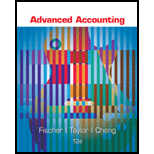
Concept explainers
a.
Business combination:
Business combination refers to the combining of one or more business organizations in a single entity. The business combination leads to the formation of combined financial statements. After business combination, the entities having separate control merges into one having control over all the assets and liabilities. Merging and acquisition are types of business combinations.
Consolidated financial statements:
The consolidated financial statements refer to the combined financial statements of the entities which are prepared at the year-end. The consolidated financial statements are prepared when one organization is either acquired by the other entity or two organizations merged to form the new entity. The consolidated financial statements serve the purpose of both the entities about financial information.
The criteria for determining whether the investor should apply the equity method of accounting to this investment or not is as follows:
- The investor should invest at least 20% or it should acquire at least 20% of the investee’s share.
- The investor should be able to exercise the significant influence over the investee.
If the above two conditions are fulfilled then the organization can use the equity method.
To Compute:
The investment income of Company R.
a.
Explanation of Solution
Compute the investment income of Company R for 2015:
Thus, the investment income of Company R for 2015 is $6,500.
Working note:
Compute the amortization on equipment:
b.
Consolidated financial statements:
The consolidated financial statements refer to the combined financial statements of the entities which are prepared at the year-end. The consolidated financial statements are prepared when one organization is either acquired by the other entity or two organizations merged to form the new entity. The consolidated financial statements serve the purpose of both the entities about financial information.
To Compute:
The balance in investment as on December 31, 2015.
b.
Explanation of Solution
Compute the investment balance of Company R as on December 31, 2015:
Thus, the investment balance of Company R as on December 31, 2015 is $173,500.
c.
Consolidated financial statements:
The consolidated financial statements refer to the combined financial statements of the entities which are prepared at the year-end. The consolidated financial statements are prepared when one organization is either acquired by the other entity or two organizations merged to form the new entity. The consolidated financial statements serve the purpose of both the entities about financial information.
To Explain:
The investment balance as on December 31, 2015, in words.
c.
Explanation of Solution
The investment balance as on December 31, 2015 has been computed by adding the share of parent company’s income in the cost of investment. The amount of dividend has been deducted from the investment balance. The amount of dividend represents the amount of amortization which is in excess of book value.
Want to see more full solutions like this?
- I am looking for a step-by-step explanation of this financial accounting problem with correct standards.arrow_forwardTotal production of 3,500 units of finished goods at Tristar Manufacturing required 15,400 actual hours at $18.75 per hour. The standard is 4.2 hours per unit of finished goods, at a standard rate of $19.00 per hour. Which of the following statements is true? a. The labor efficiency variance is $9,450 unfavorable. b. The total labor variance is $1,155 favorable. c. The labor rate variance is $3,850 favorable. d. The labor rate variance is $1,200 unfavorable.arrow_forwardCan you help me solve this general accounting question using valid accounting techniques?arrow_forward
- Could you explain the steps for solving this financial accounting question accurately?arrow_forwardDiane Fabrics has a magnitude of operating leverage of 2 at a sales level of $320,000. If sales increase by 10%, profits (net income) will increase by____.arrow_forwardCan you solve this financial accounting problem with appropriate steps and explanations?arrow_forward
 Financial Reporting, Financial Statement Analysis...FinanceISBN:9781285190907Author:James M. Wahlen, Stephen P. Baginski, Mark BradshawPublisher:Cengage Learning
Financial Reporting, Financial Statement Analysis...FinanceISBN:9781285190907Author:James M. Wahlen, Stephen P. Baginski, Mark BradshawPublisher:Cengage Learning EBK CONTEMPORARY FINANCIAL MANAGEMENTFinanceISBN:9781337514835Author:MOYERPublisher:CENGAGE LEARNING - CONSIGNMENT
EBK CONTEMPORARY FINANCIAL MANAGEMENTFinanceISBN:9781337514835Author:MOYERPublisher:CENGAGE LEARNING - CONSIGNMENT Financial AccountingAccountingISBN:9781305088436Author:Carl Warren, Jim Reeve, Jonathan DuchacPublisher:Cengage Learning
Financial AccountingAccountingISBN:9781305088436Author:Carl Warren, Jim Reeve, Jonathan DuchacPublisher:Cengage Learning



